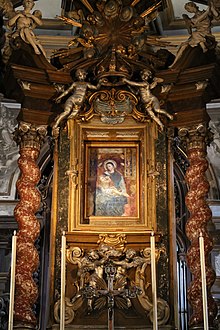
Back Korunovace obrazu Czech Krönung eines Marienbildes German Coronación canónica Spanish Couronnement canonique French Penobatan kanonik ID Maria Incoronata Italian Канонско крунисување MK Pauselijke kroning Dutch Coroação canônica Portuguese Koronasyong kanonika TL

A canonical coronation (Latin: Coronatio Canonica) is a pious institutional act of the pope, duly expressed in a formal decree of a papal bull, in which the pope bestows the pontifical right to impose an ornamental crown, a diadem or an aureole to an image of Christ, Mary or Joseph that is widely venerated in a particular diocese or locality.[1][2][3][4] The act was later regulated to Marian images only, through the De coronatione imaginum B.V. Mariae that was issued on 25 March 1973.[5]
The formal act is generally carried out by a representing proxy of the pope, via the designated apostolic nuncio to a country or kingdom, or at times a lesser papal legate, or on rare occasions by the pope himself, by ceremonially attaching a crown, tiara, or stellar halo to the devotional image or statue.[6]
The Holy Office originally issued the authorisation of a canonical coronation through a dicastery, called the "Vatican Chapter". Subsequently, until 1989, the Vatican's Sacred Congregation of Rites was assigned this duty. Since then, the Congregation for Divine Worship and the Discipline of the Sacraments makes the formal consultation and arrangement to execute the ceremonial act which the decree authorizes.[7]
- ^ "Mensaje con motivo del 50 aniversario de la coronación de la imagen de la Virgen del Camino (19 de octubre de 1980) - Juan Pablo II". w2.vatican.va.
- ^ "Radiomensaje a los fieles mexicanos con ocasión del 50 aniversario de la coronación canónica de la Virgen de Guadalupe (12 de octubre de 1945) - PIUS XII". w2.vatican.va.
- ^ "CATHOLIC ENCYCLOPEDIA: Bulls and Briefs". Newadvent.org. 1 November 1908. Retrieved 6 April 2015.
- ^ "Canonical Coronation of La Virgen de la Esperanza Macarena | Hermandad de la Macarena". Hermandaddelamacarena.es. Retrieved 6 April 2015.
- ^ "De coronatione imaginum B.V. Mariae" (PDF).
- ^ "Address to members of the Vatican Chapter". Vatican.va. Retrieved 6 April 2015.
- ^ Acta Apostolicae Sedis 1973, “De Coronatione Imaginum Beatae Mariae Virginis” — PLURIES DECURSU TEMPORIS factum est ut populus christianus, filiali devotione permotus, ardenter peteret et obtineret coronationem alicuius Imaginis Beata Virgo Mariae. Nam «Maria, per gratiam Dei post Filium prae omnibus angelis et hominibus exaltata, utpote sanctissima Dei Mater, quae mysteriis Christi interfuit, speciali cultu ab Ecclesia merito honoratur.» [Congregatione Oecumenicum Vaticanum Secundum II, Constatione Dogmatis Lumen gentium, numerorum # 66.] Illius consuetudinis testimonium permanet ritus in Pontificali Romano usitatus.